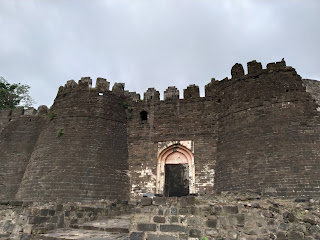What is the Place and how to reach?
Ajanta Caves of Maharashtra located between Aurangabad (100 Kms) and Jalgaon (55 Kms) is perhaps India's most eco-friendly man-made world heritage site. This place consists of around 30 caves (26 numbered and for public exhibit), belonging to Buddhism (predominantly Mahayana), carved in two distinct phases dating from c.200sBCE to c.450sCE. They are attributed to many ancient kingdoms like Guptas, Vakatakas, Satavahanas etc. These caves contain some of the best, finest and earliest paintings and sculptures of Buddhism.
The entrance point to the caves is located in a beautiful valley, 4 kms away from the village of Ajanta, connected by share autos and jeeps. Mere entry into the entrance point requires a charge of Rs.15. From the entry point, separate government buses ply to the Caves (charge of Rs.20/Rs.35) from a designated bus-bay. The entry point has a cluster of shops selling food items and
souvenirs. Further, at the caves, the entry ticket is Rs.40/- for Indians.
 |
| Bridge over Waghora river at Ajanta Caves |
What to expect?
A laid-back and serene spot where history and nature conspire with each other - I was lucky to visit this on a rainy day morning with very few tourists. The constant sound of the adjacent waterfall, a delightful drizzle that drums up the mood, and the astonishing fact of walking through and witnessing one of man's greatest creations - that's what Ajanta offered that day.
Among the caves, - Cave 1 - one of the latest to be excavated has some great life size paintings of Boddhisatvas Padmapani and Vajrapani (manifestations of Buddha). Cave 2 also has some interesting paintings, partly fragmented inspired by Jataka tales. Caves 9 & 10 are sort of experimentative Chaitya halls (prayer halls for Buddhist monks) with the Buddha-Sthupa at the centre. There is a brilliant illustration of Mudras of Buddha & Bodhisattvas in Cave 10. Cave 16 is another Chaitya hall that was described in details by the Chinese monk, Xuan Zang and is attributed to Vakatakas. It has some paintings from Buddha's life predominantly stories of his compassion. Cave 17, with a pillared hall has some fine sculptures outside the facade. Cave 20 is also another must visit place - one of the largest Chaitya halls of the site.
 |
| Boddhisatva Padmapani painting in cave 1 |
But, my favourite one of the lot is Cave 26. Cave 26 is a Mahayana Mahachaitya hall, interspersed with huge pillars. On the walls of the cave, striking hand-carved rock art depicting events from the life of Buddha are simply mesmerizing. One should not miss visiting this and two such panels still dance before my eyes - the fist is the Mahanirvana of Buddha - a 20 feet Buddha sculpture separating two distinct sub-panels - with the humans grieving his death at the bottom and celestial beings about to welcome him with joy on the top. The other one is the 'Temptation of Mara' panel - as per Buddhist mythology, the demon Mara sends his beautiful daughters and goblins to distract Buddha's penance, but the latter remains calms and unperturbed at the centre - in his 'BhoomiSparsha Mudra'.
- They had come to him glittering with beauty –
- Taṇhā, Arati, and Rāga –
- But the Teacher swept them away right there
- As the wind, a fallen cotton tuft.
- - Text from Samyutta Nikaya, describing how Buddha dealt with the daughters of Mara.
 |
| Entrance to Cave 2 |
Beware of/What not to expect?
- Touts/Shop agents who sweet talk and coerce you into buying things that you may not need. If interested in buying souvenirs, please do so only from the designated shops near the bus bay
- If you are traveling alone, the public transport is infrequent. There are government tourism buses from Aurangabad but they come with a catch - you can't explore the place at your leisure and have to adhere to their timings.
- Do not use flash photography/video once inside the caves to capture paintings. They are rapidly deteriorating and will naturally disappear in due course.
- The entrance point is the only place where you'd find food stalls, and the caves have only drinking water facility - so plan accordingly.
- If needed, Do engage a guide with valid credentials available at the entrance point only. I did not need one, as I had some awareness about the caves and am naturally interested in the subject of history.
 |
| Temptation of Mara - Cave 26 |
The Wonder that is Ajanta (On Ajanata Caves)
#MyTravels - Ajanta Caves (July 2019)


















